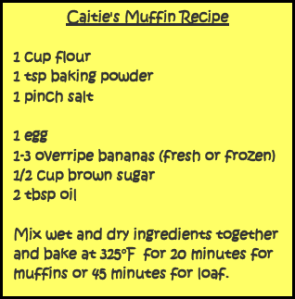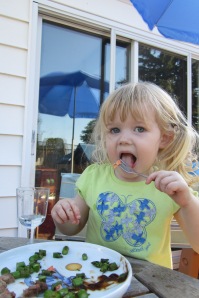The other morning I watched as a parent cornered one of Molly’s teachers and asked, “So do you subscribe to that whole ‘time-out’ philosophy?” and she struggled to answer in a way that satisfied – not because one was wrong and the other was right, but because it often seems like when two people talk about “time-out” they might as well be speaking two completely different languages.
I don’t know when exactly “time-out” got such a bad rap, but I think a big part of the problem is that 99 percent of people who do “time-out” don’t do it right and 99 percent of people who don’t do it have only ever seen it done wrong. Most people who don’t believe in “that whole ‘time-out’ philosophy” have tried it out at some point – you know, the old,
“If you don’t stop that right now I’m putting you in time-out! DID YOU HEAR ME? That’s ONE! If I have to come over there, I’m going to…THAT’S TWO! I MEAN IT! DON’T MAKE ME GET TO THREE! I’m not kidding around! You are going in TIME-OUT, MISTER!! I TOLD YOU TO STOP! OKAY, THAT’S IT!! THREE!!! YOU GO AND SIT ON THAT TIME-OUT STEP RIGHT NOW!! You’re sitting there for five minutes because you didn’t…HEY, GET BACK ON THAT STEP! I TOLD YOU TO SIT DOWN! NOW THAT’S 10 MINUTES!! WHERE ARE YOU GOING? I THOUGHT I TOLD YOU TO SIT THERE!! NO TALKING!! DON’T MAKE FACES AT YOUR SISTER!! GET BACK ON THAT STEP RIGHT NOW! NOW YOU CAN SIT THERE FOR 10 MORE MINUTES!”
– and found that for some reason it didn’t work. We’ve all been there. The key to time-out is no different from any other discipline technique: Discipline techniques that work are those that are calm and consistent. Even spanking will be effective if it’s done within those parameters. I take issue philosophically with teaching children not to hit by hitting, but as long you consistently follow through, it will certainly change the behaviour that you want it to change.

“THERE’S NO SMILING IN TIME-OUT, CHARLEY!!”
©PicklesINK 2013
1-2-3 Magic devotes an entire chapter to the false notion or “wish” (which I think is a really interesting way of looking at it) that is behind why most discipline attempts that don’t work: The Little Adult Assumption.
The Little Adult Assumption is the belief that kids have hearts of gold and that they are basically reasonable and unselfish. they’re just smaller versions of grownups, in other words. and because they are little adults, this notion goes, whenever the youngsters are misbehaving or not cooperating, the problem must be that they don’t have enough information at their disposal to be able to do the right thing.
Imagine, for example, that your eight-year-old son is torturing his little sister for the fifteenth time since they got home from school. What should you do? If your boy is a little adult, you simply sit him down, calmly look him in the eye, and explain to him the three golden reasons why he shouldn’t tease his sister. First of all, teasing hurts her. Second, it makes you mad at him. Third — and most important — how would he feel if someone treated him like that?
Your son looks you in the eye, his face brightening with insight, and he says, “Gee, I never looked at it like that before!” Then he stops bothering his sister for the rest of his life. (1-2-3 Magic, pp. 15-16)
Even well into adolescence and young adulthood, our brains are still developing and changing. Children are simply not capable of understanding or thinking rationally at the same level as adults. Part of our job as parents is give your children a safe space in which to express their feelings and opinions, but another very important part of our job is to teach our children how to act appropriately – “I understand that you are very angry, but it is not okay to throw your toys, and there are consequences to that choice.”
The parent talking to Molly’s teacher said, “We do a lot of getting down to their level and talking to them.” 1-2-3 Magic explains that while one explanation can be appropriate – it could be that your child really did not have the necessary information to act appropriate – it’s attempts at repeated explanations that can lead to trouble, adding, interestingly, “too much parent talking irritates and distracts children” (p. 17). I can certainly see that – if I’m already feeling overwhelmed by a situation and consequently acting out, the last thing I need is for someone to get right in my face and talk at me! The teacher replied, “We use a lot of redirection, but then if we have to we remove the child from the situation.” Well, ladies and gentleman, in accepting this explanation that parent may not have realized it, but what that teacher described was…drum-roll please…a time-out!
I absolutely subscribe to “that whole ‘time-out’ philosophy.” It is one of the most important discipline tools I have as a parent. In a recent blog post, Alyson Schafer noted that the word “discipline” is derived from “disciple,” meaning to teach or guide. I see time-out as a tool for teaching as well as an important skill for my children to learn, and in fact part of that involves them seeing ME taking a time-out when I need to.
As I mentioned before, the two keys to effective discipline are consistency and calmness: Firstly, in order for any discipline technique to effect a change in behaviour, it must be consistent. This means that if you say, “If you don’t do/stop doing X, I am going to Y,” and the child doesn’t do/stop doing X, you HAVE TO do Y. If you don’t do Y EVERY SINGLE TIME, your child will actually not do/not stop doing X even MORE OFTEN than if you never did Y at all. In operant conditioning, this is called a variable-ratio reinforcement schedule. In fairness to anti-time-out parent, as long as he/she is consistently “getting down to his level and talking” EVERY SINGLE TIME it will also eventually work to change the child’s behaviour – the only danger is that if the child interprets this as positive attention, it is possible that the change may not be the one the parent intends.
Second, in order for any discipline technique to work the way you want it to, it must be calm. 1-2-3 Magic calls the use of too much (negative) emotion in trying to discipline a “parental temper tantrum.” When you let your emotions get the better of you while trying to discipline, several things happen: a. You show your child that he or she has the power to cause you to lose control; b. You upset and frighten your child; and c. You probably aren’t applying your chosen discipline technique consistently.
It’s the combination of parental loss of emotional control (temper tantrum) and lack of consistency that derails most attempts at “that whole time-out philosophy.” Remember that whole, “I’m telling you, IF I GET TO THREE YOU ARE GETTING A TIME-OUT, MISTER!!”?
My goal in using time-outs is to teach my children that there are times in life when you become overwhelmed by a situation or by your surroundings, and a way to deal with that instead of “having a freak-out” is to briefly step away from the situation, calm yourself down and gather your thoughts, and then return. At this age, most of time I have to tell them when that time has come – “Molly, there is no yelling and throwing. You are going to sit out on the stair for 3 minutes because you yelled and threw your toys,” or “Ben, you need to calm down. You can go and take a time out in your room and look at books until you’re ready to stop yelling and whining,” – but my hope is that they start to recognize these times for themselves.
Just think how much simpler life would be if it were socially acceptable for us adults to say, “Could you excuse me? I’m going to take a moment to gather my thoughts.”
~ karyn






